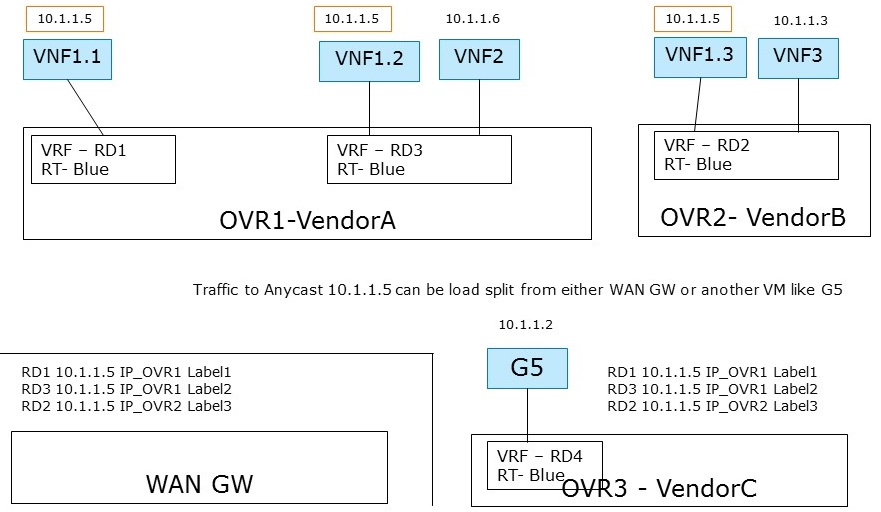2.1.2. ECMP Load Splitting Case (Anycast)¶
2.1.2.1. Description¶
There are 2 hosts (compute nodes). SDN Controller A and vRouter A are provided by Vendor A, and run on host A. SDN Controller B and vRouter B are provided by Vendor B, and run on host B.
There is 1 tenant. Tenant 1 creates L3VPN Blue with subnet 10.1.1.0/24.
The network topology is shown in Fig. 2.2:
In L3VPN Blue, VNF1.1 and VNF1.2 are spawned on host A, attached to subnet 10.1.1.0/24 and assigned the same IP address 10.1.1.5. VNF1.3 is spawned on host B, attached to subnet 10.1.1.0/24 and assigned the same IP addresses 10.1.1.5. VNF 2 and VNF 3 are spawned on host A and B respectively, attached to subnet 10.1.1.0/24, and assigned different IP addresses 10.1.1.6 and 10.1.1.3 respectively.
Here, the Network VRF Policy Resource is ECMP/AnyCast. Traffic to Anycast 10.1.1.5
can be load split from either WAN GW or another VM like G5.
2.1.2.2. Derrived Requirements¶
2.1.2.2.1. Northbound API / Workflow¶
- TBD
2.1.2.2.2. Data model objects¶
- TBD
2.1.2.2.3. Orchestration¶
- TBD
2.1.2.2.4. Dependencies on compute services¶
- TBD
2.1.2.3. Current implementation¶
Support for creating and managing L3VPNs is in general available in OpenStack Neutron by means of the BGPVPN project [BGPVPN]. However, the BGPVPN API does not yet support ECMP, but this feature is on the project roadmap. Hence, it is currently not possible to configure the networking use case as described above.
2.1.2.4. Gaps in the current solution¶
Given the use case description and the currently available implementation in OpenStack provided by BGPVPN project, we identify the following gaps:
- [L3VPN-ECMP-GAP1] ECMP is current not yet supported by the BGPVPN API. The Development of this feature is on the roadmap of the project, however. TODO: add timeline and planned API
- [L3VPN-ECMP-GAP2] It is not possible to assign the same IP to multiple Neutron ports within the same Neutron subnet. This is due to the fundamental requirement of avoiding IP collisions within the L2 domain which is a Neutron network. A potential workaround is to create two subnets with the same IP ranges and associate both with the same BGP VPN.
2.1.2.5. Conclusion¶
TBD

